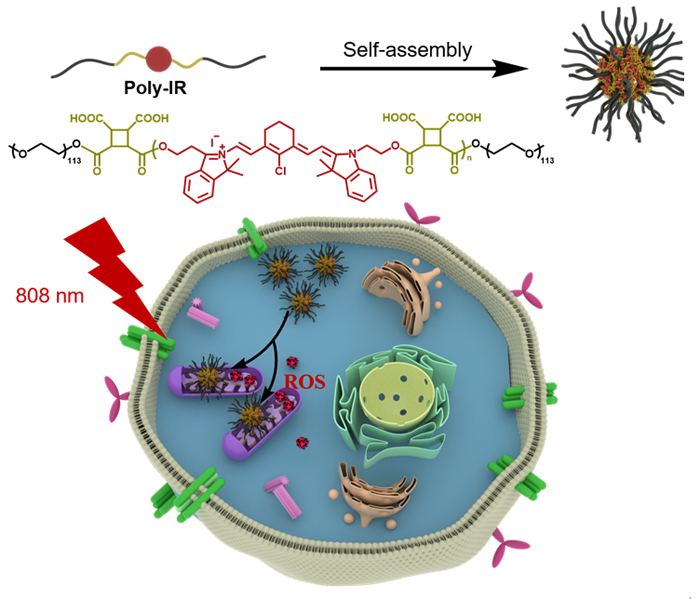| [1] |
Li, X.; Lovell, J. F.; Yoon, J.; Chen, X. Nat. Rev. Clin. Oncol. 2020, 17, 657.
doi: 10.1038/s41571-020-0410-2
|
| [2] |
Liu, C.-H.; Cao, Y.; Cheng, Y.-R.; Wang, D.-D.; Xu, T.-L.; Su, L.; Zhang, X.-J.; Dong, H.-F. Nat. Commun. 2020, 11, 1735.
doi: 10.1038/s41467-020-15591-4
|
| [3] |
Wang, T.; Zhao, L.; Wang, K.-W.; Bai, Y.-F.; Feng, F. Acta Chim. Sinica 2021, 79, 600. (in Chinese)
doi: 10.6023/A20120578
|
|
(王涛, 赵璐, 王科伟, 白云峰, 冯锋, 化学学报, 2021, 79, 600.)
doi: 10.6023/A20120578
|
| [4] |
Lismont, M.; Dreesen, L.; Wuttke, S. Adv. Funct. Mater. 2017, 27, 1606314.
doi: 10.1002/adfm.v27.14
|
| [5] |
Yan, T.; Liu, Z.-H.; Song, X.-Y.; Zhang, S.-S. Acta Chim. Sinica 2020, 78, 657. (in Chinese)
doi: 10.6023/A20040132
|
|
(闫涛, 刘振华, 宋昕玥, 张书圣, 化学学报, 2020, 78, 657.)
doi: 10.6023/A20040132
|
| [6] |
Huang, J.; Li, Z.; Liu, Z.-H. Acta Chim. Sinica 2021, 79, 1049. (in Chinese)
doi: 10.6023/A21050194
|
|
(黄菊, 李贞, 刘志洪, 化学学报, 2021, 79, 1049.)
doi: 10.6023/A21050194
|
| [7] |
Lo, P.-C.; Rodriguez-Morgade, M. S.; Pandey, R. K.; Ng, D. K. P.; Torres, T.; Dumoulin, F. Chem. Soc. Rev. 2020, 49, 1041.
doi: 10.1039/C9CS00129H
|
| [8] |
Xie, J.-L.; Wang, Y.-W.; Choi, W.; Jangili, P.; Ge, Y.-Q.; Xu, Y.-J.; Kang, J.-L.; Liu, L.-Q.; Zhang, B.; Xie, Z.-J.; He, J.; Xie, N.; Nie, G.-H.; Zhang, H.; Kim, J. S. Chem. Soc. Rev. 2021, 50, 9152.
doi: 10.1039/D0CS01370F
|
| [9] |
Cai, Z.; Zhang, Y.-W.; Jiang, L.-P.; Zhu, J.-J. Acta Chim. Sinica 2021, 79, 481. (in Chinese)
doi: 10.6023/A20120583
|
|
(蔡政, 张颖雯, 姜立萍, 朱俊杰, 化学学报, 2021, 79, 481.)
doi: 10.6023/A20120583
|
| [10] |
Lucky, S.-S.; Soo, K.-C.; Zhang, Y. Chem. Rev. 2015, 115, 1990.
doi: 10.1021/cr5004198
|
| [11] |
Xiong, H.-J.; Zhou, D.-F.; Zheng, X.-H.; Qi, Y.-X.; Wang, Y.-H.; Jing, X.-B.; Huang, Y.-B. Chem. Commun. 2017, 53, 3422.
doi: 10.1039/C6CC10059G
|
| [12] |
Qin, Y.-B.; Yang, P.-X.; Shi, S.-B.; Sun, H.-F.; Zhang, C.-N.; Kong, D.-L. Acta Polymerica Sinica 2018, 7, 909. (in Chinese)
|
|
(秦怡博, 杨鹏翔, 时圣彬, 孙洪范, 张闯年, 孔德领, 高分子学报, 2018, 7, 909.)
|
| [13] |
Wang, R.; Li, X.-S.; Yoon, J. ACS Appl. Mater. Interfaces 2021, 13, 19543.
doi: 10.1021/acsami.1c02019
|
| [14] |
Rustin, P. Nat. Genet. 2002, 30, 352.
doi: 10.1038/ng0402-352
|
| [15] |
Yang, Z.-G.; Xiong, J.; Zhang, W.; Li, W.; Pan, W.-H.; Zhang, J.-G.; Gu, Z.-Y.; Huang, M.-N.; Qu, J.-L. Acta Chim. Sinica 2020, 78, 130. (in Chinese)
doi: 10.6023/A19100374
|
|
(杨志刚, 熊佳, 张炜, 李文, 潘文慧, 张建国, 顾振宇, 黄美娜, 屈军乐, 化学学报 2020, 78, 130.)
doi: 10.6023/A19100374
|
| [16] |
Marrache, S.; Pathak, R. K.; Dhar, S. Proc. Natl. Acad. Sci. U. S. A. 2014, 111, 10444.
doi: 10.1073/pnas.1405244111
pmid: 25002500
|
| [17] |
Wang, K.; Zhu, C.-C.; He, Y.-F.; Zhang, Z.-Q.; Zhou, W.; Muhammad, N.; Guo, Y.; Wang, X.-Y.; Guo, Z.-J. Angew. Chem. Int. Ed. 2019, 58, 4638.
doi: 10.1002/anie.v58.14
|
| [18] |
Li, X.-Z.; Wu, J.-G.; Wang, L.; He, C.; Chen, L.-Y.; Jiao, Y.; Duan, C.-Y. Angew. Chem., Int. Ed. 2020, 59, 6420.
doi: 10.1002/anie.v59.16
|
| [19] |
Lv, W.; Zhang, Z.; Zhang, K. Y.; Yang, H.-R.; Liu, S.-J.; Xu, A.-Q.; Guo, S.; Zhao, Q.; Huang, W. Angew. Chem., Int. Ed. 2016, 55, 9947.
doi: 10.1002/anie.201604130
|
| [20] |
Han, K.; Lei, Q.; Wang, S.-B.; Hu, J.-J.; Qiu, W.-X.; Zhu, J.-Y.; Yin, W.-N.; Luo, X.; Zhang, X.-Z. Adv. Funct. Mater. 2015, 25, 2961.
doi: 10.1002/adfm.201500590
|
| [21] |
Jiang, C.-X.; Cheng, H.; Yuan, A.-H.; Tang, X.-L.; Wu, J.-H.; Hu, Y.-Q. Acta Biomater. 2015, 14, 61.
doi: 10.1016/j.actbio.2014.11.041
|
| [22] |
Mitra, K.; Lyons, C. E.; Hartman, M. C. T. Angew. Chem., Int. Ed. 2018, 57, 10263.
doi: 10.1002/anie.v57.32
|
| [23] |
Zhu, H.-J.; Li, J.-C.; Qi, X.-Y.; Chen, P.; Pu, K.-Y. Nano Lett. 2018, 18, 586.
doi: 10.1021/acs.nanolett.7b04759
|
| [24] |
Thomas, A. P.; Palanikumar, L.; Jeena, M. T.; Kim, K.; Ryu, J. H. Chem. Sci. 2017, 8, 8351.
doi: 10.1039/c7sc03169f
pmid: 29619181
|
| [25] |
Sun, J.; Du, K.; Diao, J.-J.; Cai, X.-T.; Feng, F.-D.; Wang, S. Angew. Chem., Int. Ed. 2020, 59, 12122.
doi: 10.1002/anie.v59.29
|
| [26] |
Zhang, Q.-F.; Kuang, G.-Z.; He, S.-S.; Lu, H.-T.; Cheng, Y.-L.; Zhou, D.-F.; Huang, Y.-B. Nano Lett. 2020, 20, 3039.
doi: 10.1021/acs.nanolett.9b04981
|
| [27] |
Yang, G.-L.; Tian, J.; Chen, C.; Jiang, D.-W.; Xue, Y.-D.; Wang, C.-C.; Gao, Y.; Zhang, W.-A. Chem. Sci. 2019, 10, 5766.
doi: 10.1039/C9SC00985J
|
 )
)
